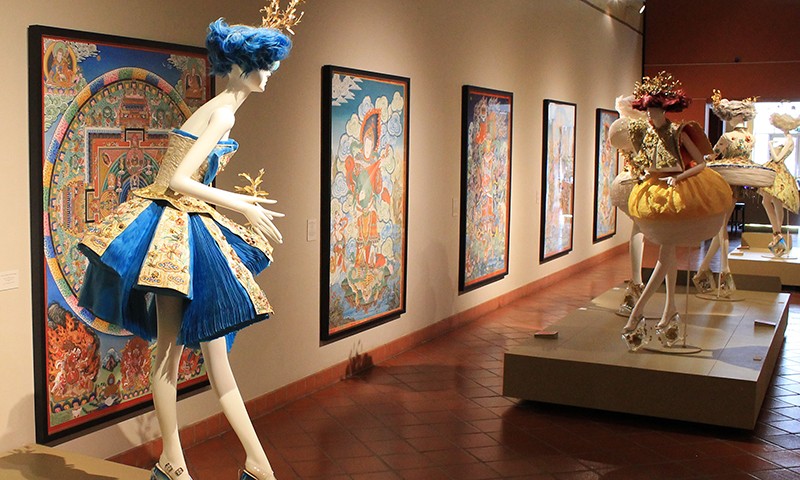 |
| Guo Pei's Garden of Soul collection backed by Shashi Dhoj Tulachan's paintings. |
Fashion 101
Recent visitors to the Bowers Museum will have noticed a few new faces—placid as they may be—in the Freedman Galleria, the long hallway travelling between our main desk and the Bowers Museum’s changing gallery spaces. Of course, these seven new, poised visitors to the Bowers Museum are each sporting the vivacious and bubbly dresses of Guo Pei’s Garden of Soul collection. This post is only partially about these seven show-stoppers. Instead it looks to the Galleria’s eight paintings on semi-permanent display as part of the Bowers Museum’s Sacred Realms: Temple Murals by Shashi Dhoj Tulachan exhibition, exploring the interplay between these mineral pigment didactics and Guo Pei’s haute couture creations.
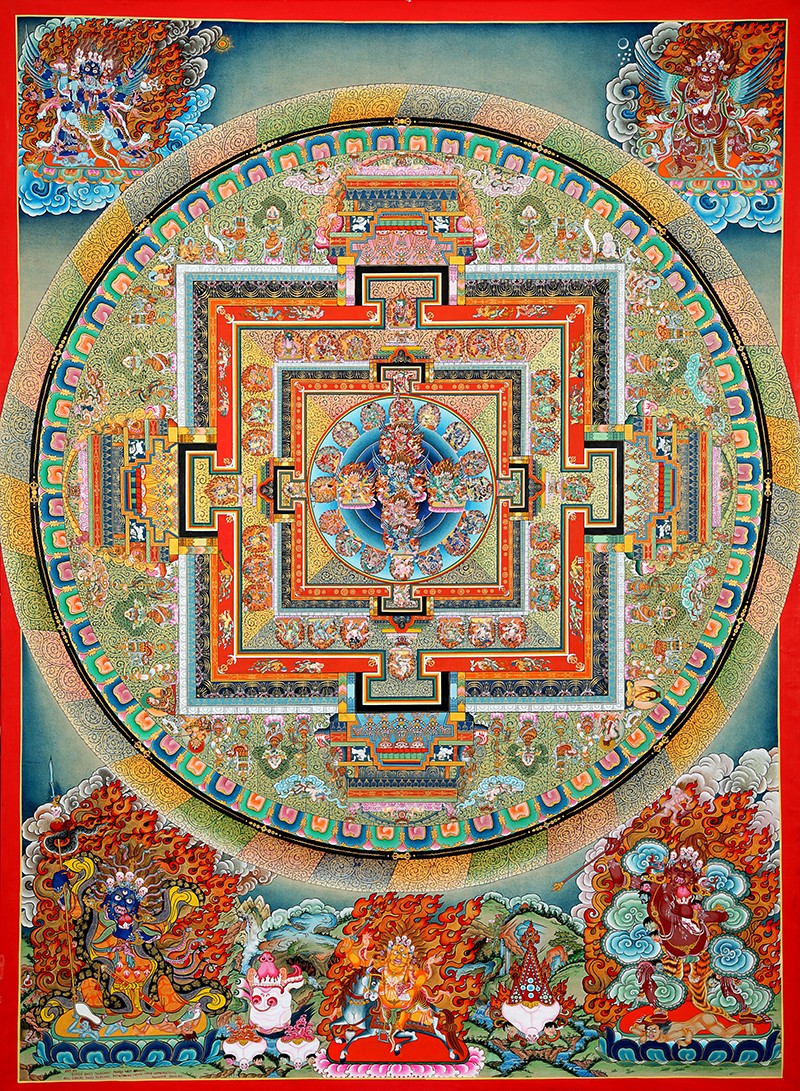 |
Peaceful-Wrathful Deities Mandala, 2004
Shashi Dhoj Tulachan; Nepal
Natural mineral pigments
L.2012.25.3
Loan courtesy of Gayle and Edward P. Roski |
Monk Monet
As the exhibition’s title hints, the contemporary works were painted by Shashi Dhoj Tulachan, a Buddhist monk who lives in Tuksche, a village in Nepal’s Mustang District bordering on Tibet. Tulachan comes from a long line of Buddhist artists renowned for painting both large temple murals and the portable thangka paintings so associated with Tibetan Buddhism. At the young age of 9 he began helping his father, Kamal Dhoj Tulachan, with his commissions and in 1961 at the age of 18 he had already received his first solo commission to work on the murals for the Mani Lha K'an temple, also in Mustang. Ever since he has continued to develop as a painter, relying on ancient motifs but using vibrant anachronistic pigments to create works that are simultaneously deeply rooted in the history of Tibetan Buddhism and the product of the modern era. He is also deeply involved in the restoration of religious sites, with the proceeds of his sales devoted to the restoration of the Chhairo Gompa, an 18th Century Tibetan monastery.
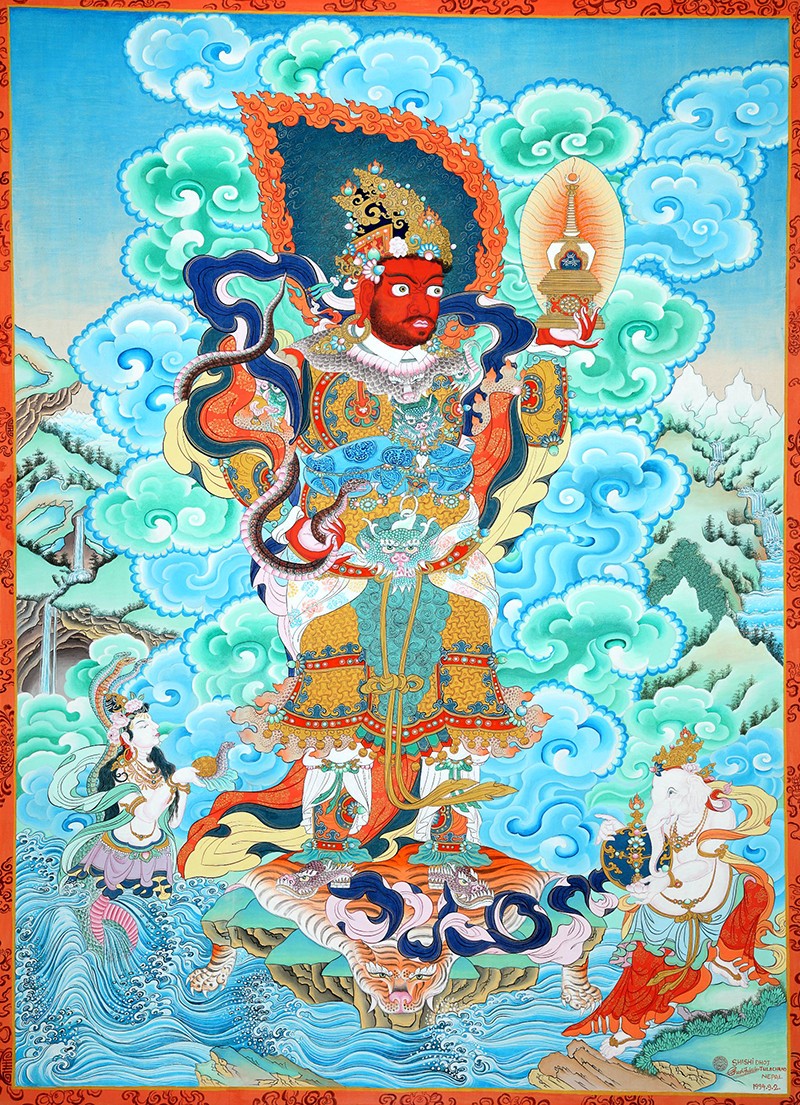 |
Virupaksa (Dharma King of the West Direction), 1994
Shashi Dhoj Tulachan; Nepal
Natural mineral pigments
L.2012.25.7
Loan courtesy of Gayle and Edward P. Roski |
Thangkas for the Memories
Though the 8-foot-tall paintings in the Freedman Galleria fall slightly outside of established norms for both traditional types of Tibetan paintings they are referred to in the exhibition as mural paintings due to their large size and relatively stationary status. Thangka paintings were originally designed to be smaller scroll paintings averaging only 24 inches in height by 16 inches in width. Compared against the much larger mural paintings of the same region, the utility of thangkas lay in their transportability. These paintings follow many of the tenets of historic Tibetan painting. The composition of the works relies on several archetypes, mostly those originally hailing from the Tibetan Karam Ghadri School of Tibet which is held in high esteem by Tibetan monks to this day. Of the eight paintings in the Galleria, four of them are mandalas—geometric representations of the universe, usually including Buddhist deities—and the remaining four are the cardinal Dharma Kings: Vaisravan of the north, Dhrtarastra of the east, Virudhaka of the south and Virupaksa of the west. The ninth painting by Shashi Dhoj Tulachan is based on Avalokiteśvara and was previously featured in Who Answers the Cries: Guanyin at the Bowers.
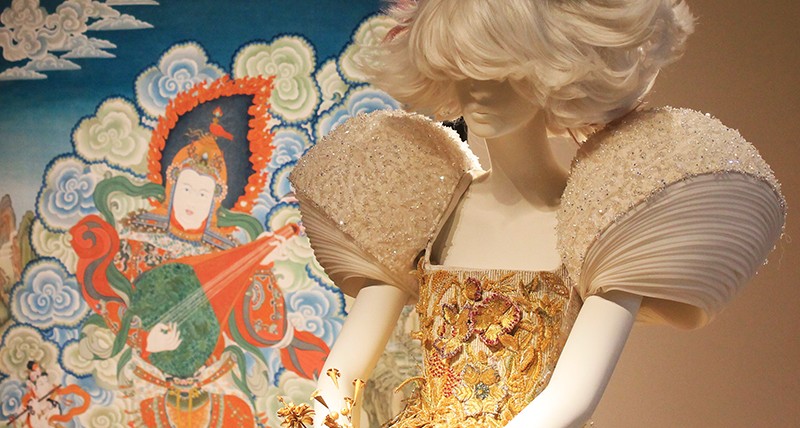 |
| Garden of Soul dress with Shashi Dhoj Tulachan's Dhrtarastra (Dharma King of the East Direction). |
Scratching Samsara’s Surface
So why is it that these paintings pair so well with 21st Century haute couture? On the surface they share little in common. A closer examination reveals this, however: Guo Pei’s early collections are heavily rooted in Buddhist tradition, particularly her Samsara collection whose title refers to the cycle of life, death and rebirth to which the material world is bound in Buddhism. Though the two Samsara dresses in Guo Pei: Couture Beyond are from the collection’s day cycle—thus the splendid golden hues of dawn—almost half of the collection was painted in the somber blues of nighttime. While the designs rely heavily on Han Chinese motifs such as dragons, the geometry seen in Guo Pei’s dresses as well as their shape both speak to a greater Buddhist inspiration.
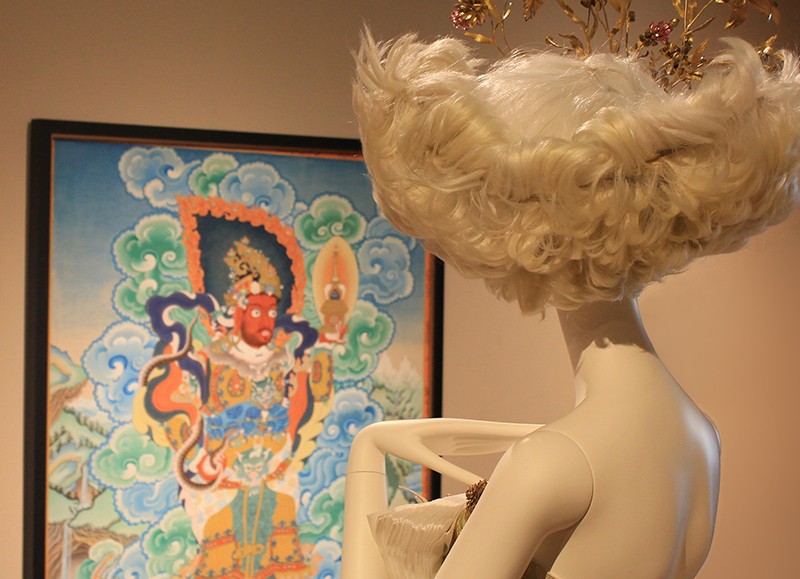 |
| Garden of Soul dress with Shashi Dhoj Tulachan's Virupaksa (Dharma King of the West Direction). |
Complementary Collars
The Garden of Soul collection in the Freedman Galleria is more philosophically distanced from Tibetan Buddhism, created as it was for a 2015 collaboration with M·A·C cosmetics; all the same the ways in which the pairing of the two collections is striking. So much can be said about the way the primary palettes of both Guo Pei’s dresses and Shashi Dhoj Tulachan’s paintings complement one another. The azures of a thangka painting’s sky might pick up a highlight from a gem-inlaid butterfly or flower. The gravitationally unaffected and deep auburn wig of a mannequin might, at just the right angle, mimic the halos of fire surrounding a thangka’s wrathful deities. Posed in bold or bashful stances the mannequins themselves appear to be reacting to the beautiful and grotesque images depicted on the canvases behind them. Garden of Soul was inspired in large part by a visit to the same garden in Saint-Rémy where Van Gogh painted Irises (1889). Like most flowers, irises only bloom seasonally, budding in spring and wilting with the first chill of autumn. Perhaps Guo Pei’s inspiration from the collection, the same ephemeral florae that healed Van Gogh’s damaged psyche, brought with them a sense of the cyclical and it has given her dresses and Shashi Dhoj Tulachan’s paintings a subject to discuss in silent harmony.
Guo Pei: Couture Beyond is organized by the Bowers Museum in collaboration with Guo Pei’s Rose Studios, SCAD FASH Museum of Fashion + Film and SCAD: The University for Creative Careers. Text and images may be under copyright. Please contact Collection Department for permission to use. References are available on request. Information subject to change upon further research.






Comments 2
This was a journey into an area that I visited in Ashmolean Museum two or three years ago, essay online Tibetan Buddhism.
Great Experience, the Oxford Ashmolean Museum digital library provided information on Tibetan Buddhism and art.
This wonder of Bowers Museum was exceptional and worth much more viewing time which we did not have on Saturday. Thank you for such great ideas in the exhibition halls. atk